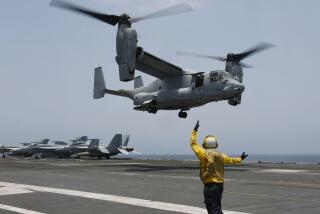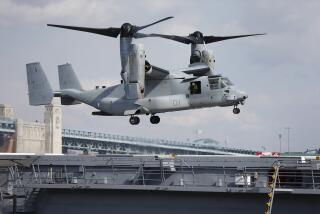Accident-Prone Harrier Jet Faces Further Investigation
- Share via
WASHINGTON — The chairman of the House panel that funds the Pentagon said he will begin an inquiry into whether the Marine Corps’ crash-prone Harrier attack jet should continue flying.
Rep. Jerry Lewis (R-Redlands), who heads the House Appropriations subcommittee on defense, said in an interview that he will press the Marines to justify the need for their signature jump jet and provide assurances that the aircraft’s performance will not continue to be a “disaster.”
Lewis said he will hold hearings on the Harrier this year or join forces with the Armed Services Committee, which already plans to do so.
“When an asset in operation has failed at the level that this has failed and cost us the number of lives that this has, there are fundamental and basic questions that you have,” Lewis said.
“Do you need this asset in view of the history we’ve seen? And if so, tell me why, and how you can assure us that we will not continue on the pathway that most recently has been nothing short of a disaster?”
The Harrier is expected to fly another 13 to 17 years before being replaced by the Marines’ special version of the Joint Strike Fighter, the next-generation combat jet now in development.
Lewis’ comments were made in a recent interview about disclosures in a Los Angeles Times series published last month.
The stories detailed the Harrier’s 31-year record as the most dangerous plane in the U.S. military — as well as the marginal combat benefits provided to date by the jet’s unique technology, which enables it to take off and land like a helicopter. The Harrier has been involved in 143 major accidents that killed 45 Marines, including some of the corps’ most accomplished pilots. A third of the fleet has been destroyed.
The series documented recurrent mechanical failures, maintenance deficiencies and chronic funding problems that led to crashes and deaths. The plane has been grounded so often that pilots often couldn’t get enough flight time to remain proficient, contributing to additional accidents.
“There’s no doubt we have to do more than lightly probe,” Lewis said. “It’s one thing to talk about airplanes and another to talk about human talent that is irreplaceable.”
Rep. John P. Murtha (D-Pa.), the ranking minority member on the defense appropriations subcommittee and a former Marine, said that in light of the Harrier’s safety record, he also intends to examine what threat the plane is needed to counter and ask how many are required to do so.
Murtha — a 28-year House veteran and one of the Marines’ most powerful congressional allies — said in an interview that he would determine whether more money is needed to ensure that Harrier pilots receive enough flight hours to remain proficient in the challenging aircraft. “The hours is something I’ll look at right away,” he said.
Lewis said he plans to coordinate any investigation with Rep. Duncan Hunter (R-Alpine), the House Armed Services Committee chairman who pledged earlier this month to hold hearings on military aviation safety, focusing on the Harrier. Lewis said both panels could sponsor a series of joint hearings or each could hold separate sessions.
Two weeks ago, Hunter extracted a pledge from the Marine aviation chief, Lt. Gen. Michael A. Hough, to increase Harrier pilots’ hours from an average of 13 a month to 17 to 20. The Marines say a Harrier pilot needs a minimum of 15 to 20 hours. In 2000, the pilots averaged 8.2 hours.
Marine spokesmen declined to comment on the lawmakers’ remarks. But the prospective hearings have drawn support from Gen. James L. Jones, who stepped down as Marine Corps commandant last week. Jones said the hearings would provide a forum “to share the good-news story” of the recent progress the Marines say they have made with the problem-plagued Harrier.
“In the last 3½ years, I have focused on that particular aircraft in direct partnership with Rolls-Royce,” which makes the plane’s engine, Jones said. “We have invested the money [and other resources] to completely overhaul the engines. The airframe on the Harriers is one of the youngest” in the U.S. military.
The Marines are rebuilding nearly half the 154-aircraft fleet, at a cost of $28.2 million per plane.
Jones said the Harrier is now “doing extremely well” in supporting troops in Afghanistan.
Although three Harriers crashed in the past year alone, Jones said, “I’m personally and professionally satisfied that we have made the fixes that are required to guarantee that the Harrier will get us safely to the Joint Strike Fighter.”
More to Read
Sign up for Essential California
The most important California stories and recommendations in your inbox every morning.
You may occasionally receive promotional content from the Los Angeles Times.










